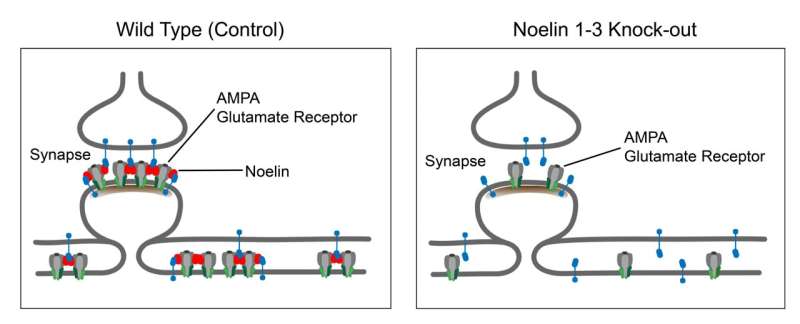This article has been reviewed according to Science X's editorial process and policies. Editors have highlighted the following attributes while ensuring the content's credibility:
fact-checked
peer-reviewed publication
trusted source
proofread
Scientists discover external protein network can help stabilize neural connections

The Noelin family of secreted proteins bind to the external portion of AMPA glutamate receptors and stabilize them on the neuronal cellular membrane, a process necessary for transmission of full-strength signals between neurons, according to a study in mice from the National Eye Institute (NEI) and the University of Freiberg, Germany. Without this external, stabilizing protein network, the AMPA receptors are no longer retained at the synapse, leading to weak, short-lived synaptic signals.
The findings not only provide insight into processes such as learning and memory but also the development of blinding conditions like glaucoma. The study was published in the journal Neuron.
"This study shows that Noelins have a crucial job in supporting synapse function in the brain and other neural tissues like the eye's retina," said Stanislav Tomarev, Ph.D., chief of NEI's Section on Retinal Ganglion Cell Biology and co-senior author of the report.
Neurons pass signals from one cell to the next via synapses, specialized connection points between the two cells. The main excitatory synapses in the brain are glutamatergic, meaning that they use the chemical messenger glutamate to transmit their signals across the synapse.
The presynaptic "sending" cell emits glutamate, which travels across the synaptic cleft and is sensed by glutamate receptors on the postsynaptic "receiving" cell. These glutamate receptors are ion channels; when the channels sense glutamate, they open, generating a new neuronal signal within the postsynaptic cell. In order to generate a strong signal, sufficient receptors must be present in the correct location of the cell's surface at the synapse.
In a new study, a team of researchers led by Tomarev and Bernd Fakler, M.D., University of Freiberg, used biochemical and genetic methods to explore the complex network of extracellular proteins maintaining the localization of AMPA-type glutamate receptors at neural synapses.
The researchers first took mouse brain tissue, and isolated cellular membranes and their attached proteins. Using mass spectroscopy and specialized analytic techniques, the team worked out which proteins were associating with AMPA receptors in these membranes.
The Noelin family of proteins (primarily Noelin 1, but also Noelins 2 and 3, also known as Olfactomedins 1, 2, and 3, respectively), were strongly associated with the AMPA receptors. The researchers also found secreted and membrane-anchored proteins like Neuritin and Brorin, which are known to be present at synapses.
To better understand how the Noelins help regulate neuronal activity, the researchers developed mice lacking all three Noelin proteins. Without Noelins present, synapses in the mouse hippocampus had many fewer AMPA glutamate receptors. And when the researchers attempted to stimulate neurons lacking Noelins, the neuronal signals were much lower than normal.
However, the neuronal signals weren't just lower. One of the key steps in memory formation is long-term neuron signaling, also known as long-term potentiation. This is achieved through recruitment and stabilization of additional glutamate receptors at the synapse over time, leading to a sustained signal through the neuron. In the brains of mice lacking Noelins, this stabilization didn't take place, meaning that not only were the neural signals low, they were short-lived as well.
"While this first study showed the Noelins' role in the brain, these proteins are highly prevalent in the retina as well," Tomarev said. "Our next task is to understand how changes in these secreted protein networks contribute to the development of retinal disorders, including glaucoma."
More information: Bernd Fakler, A Noelin-organized extracellular network of proteins required for constitutive and context-dependent anchoring of AMPA-receptors, Neuron (2023). DOI: 10.1016/j.neuron.2023.07.013. www.cell.com/neuron/fulltext/S0896-6273(23)00546-9




















